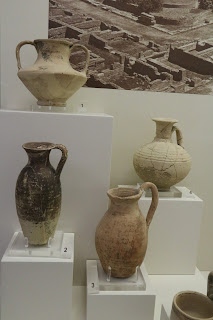Emmie speaks a little about death in Greece today. There is no embalming so burials quickly follow death. There is also no cremation as it is forbidden by the Orthodox church to which about 96% belong. Bodies, if viewable, are dressed in new clothes and covered with flowers, viewed at an open house, then buried in a wooden coffin, typically in above ground vaults. After 3-5 years, they are exhumed and bones are stored in a box either at home or in a chapel, so the burial place can be re-used. Some keep a flame burning there for up to 40 days. The widows wear black the rest of their lives. Girls who die young are dressed as a bride and buried in a white coffin, boys are dressed as a groom.
We pass many fields with plants covered with plastic. Many fields with cut or bailed hay.
Partially built homes are seen fairly often, most likely stopped due to the financial crisis. When you begin to build you are allowed to take up to 10 years, so many people build slowly over time. Only when complete do they pay taxes, but the crisis has left many unable to build.
We stop at a shop which gives us an olive oil tasting. Interesting and informative - and tasty too. There are a myriad of flavors and all are extra virgin oils - from the first pressing. A second pressing produces oil used commercially and the "dregs" that are left are used in bricks for construction.
We buy a small bottle with herbs. There are also several types of olives one of which is called raisin olives as they are dried and somewhat shriveled. I try one but no, I still don't like olives. Greg does though.
There is a university in Patmas, which brings up the topic of education. One of Greece's many problems these days is the "brain drain". Many who complete a degree then leave the country because they are unable to find work here.
We arrive at Olympia and meet our guide, Sasha. Very enthusiastic and fun. It sprinkles a little as we begin the tour but soon clears.
The first Olympics were 1 running event and for locals only. Gradually it grew to all of Greece and events such as boxing, discus, javelin and different running events were added. Later the Romans added buildings too. The fact that this site was inhabited from 5000BC or so, makes excavation time consuming and difficult, as various groups lived here at different times and left different items. Sometimes a later group either destroyed or re-worked existing materials, so you have temples to Earth Mother before temples to Hera, which may become a christian church at some point and then a turkish site, etc. etc. Whew! We see a bathtub which was in the gymnasium, and walk a trail with remnants of what was the walk of fame/walk of shame.
Statues of the winners lined one side of the trail, statues of cheaters lined the other side. Everyone in the area suspended any wars that were being fought so that athletes could travel safely. Women were not allowed, although there is a story of one woman who dressed as a man and attended (but not to compete). 776 BC were the first ancient games. There was only one winner, who received only the wreath of olive branches - and fame, of course, for he was not considered a mere human but somewhere between man and god. Here are Greg and I in front of the temple of Hera. Nearby is a rather nondescript basin where the Olympic torch is still lit.
We walk through an arch (which used to be a tunnel) and onto the Olympic field.
A few energetic youngsters are racing back and forth. Hard to imagine 40,000 spectators sitting around the field, cheering their naked men on. The athletes were naked to show that they carried no weapons and because the human form was considered beautiful.
The museum is awe-inspiring. Just imaging artists working on these things thousands of years ago is mind boggling to me!
Ambrosia Garden is a lovely nearby restaurant where we have a greek salad and chicken giouvisi - a kind of stew with eggplant, tomatoes and squash.
Greg is in red with his back to camera. Across from him are Steve and Eddie - he was a lutheran minister for 40 years and they are an interesting couple. There is a group of 6 women from San Diego area who travel together, a pair from Ontario, folks from Arizona and Florida and Pa. Our guide, Emmie, is from North Carolina originally but has lived in Greece since before the 2004 Olympics.
Today's travel was on a nice highway with essentially a three-lane road with the center shared for passing. We made a supermarket stop on the way back where Beth bought some Ion Chocolate with Hazelnuts, recommended by Emmie. Yum. Most places on the mainland we have been able to drink the tap water, though some still prefer bottled. We have done both with no ill effects.
Tomorrow, May 1, is a Worker's Holiday here - kind of like Labor Day. But it is also a day when some workers strike. Emmie says she is glad we weren't scheduled for a ferry ride because they will probably strike. May 1 is also a celebration of Spring and many homes and businesses hang wreaths of flowers that day.
We skip dinner, have some wine, and enjoy the sunset from the hotel.






















No comments:
Post a Comment